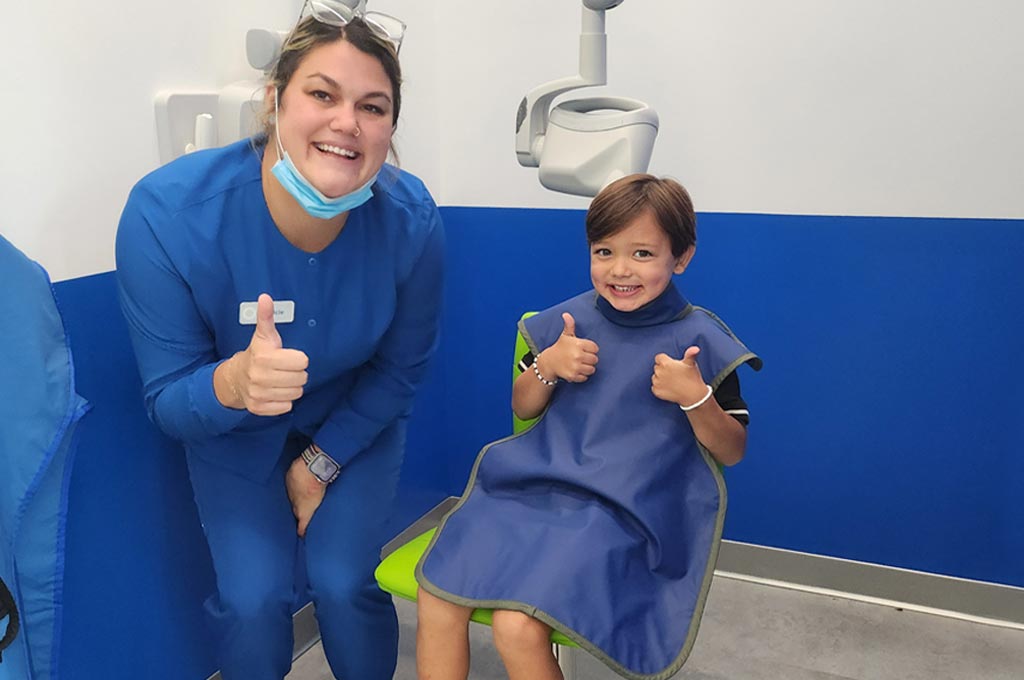How Does a Cavity Form and How Can I Prevent or Cure It?
HELLO! Dr. Ben,
I’m a mom of two — Henry (age 4) and Olivia (age 7). I always try my best to keep their teeth healthy. We limit sugary snacks, brush twice a day and visit the dentist for regular checkups. But Olivia recently got her first cavity and now I’m nervous Henry will be next. Can you explain how cavities form and tell me how I can protect my kids’ teeth? If a cavity does appear, what should I do?
Sincerely,
Worried Mom in Blue Springs
Dr. Ben’s Response…
HELLO! Worried Mom in Blue Springs,
First, thank you so much for asking. At HELLO! Pediatric Dentistry, we are asked this question a lot and we know how nerve-racking it can be to hear your child has a cavity. The good news is cavities are common in childhood and there’s a lot you can do to prevent them (and handle them if they do happen). Let me break down exactly what causes cavities.
What Exactly is a Cavity?
A cavity is a small hole in the tooth that develops when the hard outer shell of the tooth (called the enamel) starts to break down. This happens usually due to acid attacks on the enamel. The major villains behind these acid attacks are the bacteria in our mouths, particularly those that thrive on sugary and starchy foods. In fact, simple carbohydrates found in common snack foods — like crackers and ever-popular staple, Goldfish — cause more cavities for the patients we see than candy or sweets! When these bacteria feed on leftover bits of carbs and sugars, they produce acid. Over time, acid can wear away the enamel, leading to a small hole in the tooth, which leads to a cavity.
How Do Cavities Develop Quickly or Slowly Over Time?
Here’s a simple, step-by-step look at the cavity process:
- Carbs and Sugar on Teeth: Kids love sweet treats (and who can blame them? Don’t we all?). But simple carbohydrates in snack foods — like crackers, chips and bread — stick to teeth and create the perfect environment for cavity-causing bacteria.
- Bacterial Growth: Remember experiments from science class? Bacteria has to eat, and bacteria living on teeth and gums produce acids as a byproduct of their sugar and carb feast.
- Acid Attack: These acids cling to the teeth and gradually erode the enamel layer if not brushed and flossed off properly.
- Enamel Breakdown: Thanks to repeated acid attacks, weak spots develop on the tooth’s surface. That’s often when we first see white spots or dark areas.
- A Cavity is Formed: Eventually, the enamel is worn away enough to create a tiny hole (cavity). If not taken care of quickly, the damage can spread to deeper layers of the tooth, causing pain and infection.
How Can You Prevent Cavities? Here are Five Easy Ways.
- Increase How Often Kids Brush: Brushing quality is important, but brushing frequency is even more important! The best way to fight cavities is to brush more often with a fluoridated toothpaste. While two times a day is a good baseline, some kids need to brush three or even four times a day — especially if they snack frequently (see more on that below) — to effectively prevent decay. Parents should supervise or assist brushing until their children are around 7 or 8 years old to ensure every nook and cranny gets clean.
- Limit Snacking Frequency: It’s not just about what kids eat — it’s how often they snack. Frequent snacking throughout the day is a bigger risk for cavities than having a single sugary treat. Saliva helps neutralize acids in the mouth, but if a child is constantly snacking (even on healthy foods like fruit), their teeth are under constant attack. Try to schedule snack times rather than allowing all-day grazing.
- Eliminate Sugary Drinks: Juice, soda and sports drinks provide no health benefits and I advocate for avoiding them. Even 100% fruit juice is loaded with sugar and contributes to cavities. Instead, opt for plain water or if your child wants some flavor, zero-calorie options like Mio or Crystal Light are better alternatives.
- Use Fluoride: Fluoride fights against cavities. It helps strengthen tooth enamel, making it more resistant to acid attacks. Many toothpastes and municipal water sources contain fluoride (including Blue Springs).
- Regular Dental Checkups: You’re already on the right track by bringing your children in for dental visits. We recommend checkups every six months (or as advised by your dentist). Professional cleanings remove plaque and tartar you can’t reach at home and exams can catch cavities in their earliest stages, helping us treat them in a less invasive way. Related reading: Why Your Child Needs a Pediatric Dentist Instead of the “Family Dentist”
How Are Cavities Treated?
If a cavity does form, it’s important to address it quickly.
Early Detection: We check for signs of decay during routine exams and use X-rays to look for any hidden issues. The earlier we catch cavities, the less invasive the treatment needs to be.
Painless Treatment: At HELLO! Pediatric Dentistry, we treat cavities painlessly, whether a child needs a simple filling, crown, nerve treatment or even an extraction.
Fillings & Sealants: In most cases, a dental filling is used to repair the tooth. During this procedure, the decayed portion of the tooth is gently removed and the hole is filled with a safe, durable material. Finally, a sealant is placed on the chewing surfaces of the back teeth (where most cavities form). Sealants can help prevent new cavities from forming in deep grooves and crevices.
Preventing Cavities in a Nutshell
While cavities are common, they’re largely preventable with the right habits. Encourage kids to brush and floss regularly, make smarter snack choices and keep up with dental visits. If your child does get a cavity, a quick visit to HELLO! Pediatric Dentistry will help us develop a plan to treat it. Regular checkups can help catch them early.
While cavities are common, they’re largely preventable with the right habits. Encourage your kids to brush more often, limit snacking frequency, eliminate sugary drinks and floss for gum health. Side note: I always tell parents flossing is great, but I would much rather have the kids brush a third time each day if I had to choose. Keep up with regular dental visits to catch cavities early and prevent more invasive treatments.
Whether you have more questions about preventing cavities or need to schedule a filling, we’re here to help every step of the way. Get in touch.




